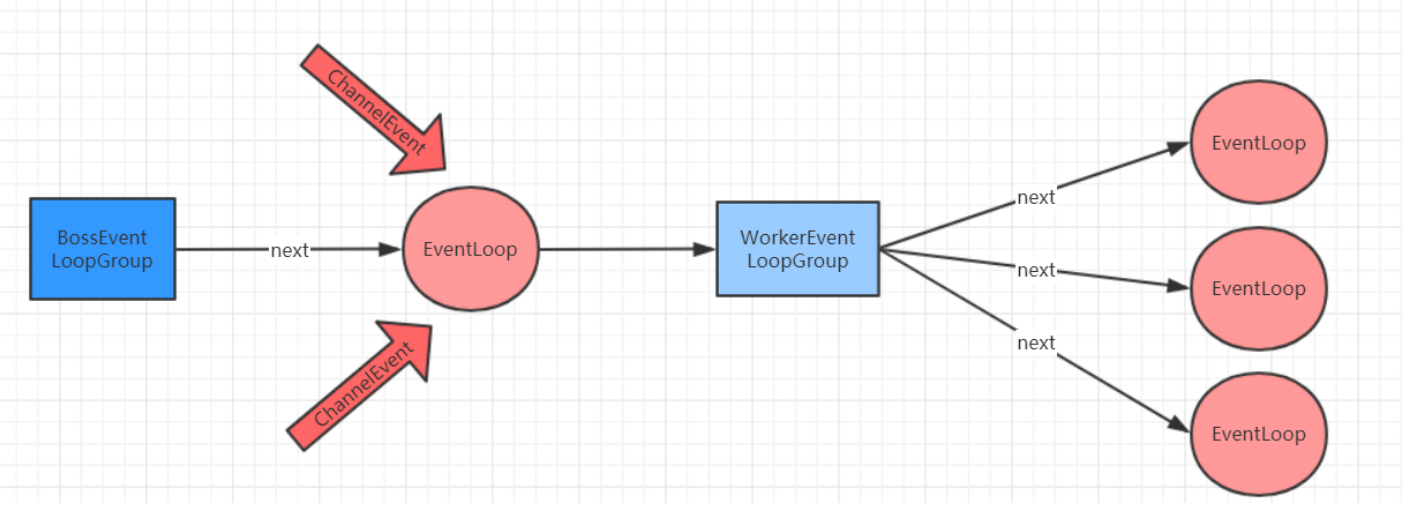目录
- Netty核心API
- ChannelHandler及其实现类
- ChannelPipeline
- ChannelHandlerContext
- ChannelOption
- ChannelFuture
- EventLoopGroup和实现类NioEventLoopGroup
- ServerBootstrap和Bootstrap
- Unpooled类
- Netty入门案例
- 引入依赖
- Netty服务端编写
- Netty客户端编写
Netty核心API
ChannelHandler及其实现类
ChannelHandler 接口定义了许多事件处理的方法,我们可以通过重写这些方法去实现具体的业务逻辑。API 关系如下图所示

Netty开发中需要自定义一个 Handler 类去实现 ChannelHandle接口或其子接口或其实现类。
主要有两类:
ChannelInboundHandler:数据流向是从外面传进来的,Netty接收到数据后,经过若干 InboundHandler 处理后接收成功。例如channelRead,外面传数据来了,管道有数据了就会触发;channelActive,外面请求连接,管道被激活了就会触发。ChannelOutboundHandler:数据流向是从内向外发的,Netty要输出数据,就需要经过若干个 OutboundHandler 处理完成后发送。例如bind,绑定端口;connect,连接;disconnect,断开连接;close关闭通道;write写数据。
可通过重写相应方法实现业务逻辑,一般都需要重写以下方法:
public void channelActive(ChannelHandlerContext ctx),通道就绪事件public void channelRead(ChannelHandlerContext ctx, Object msg),通道读取数据事件public void channelReadComplete(ChannelHandlerContext ctx),数据读取完毕事件public void exceptionCaught(ChannelHandlerContext ctx, Throwable cause),通道发生异常事件
ChannelHandlerContext 代表的是ChannelPipline链上的节点。
Netty也提供了一些自带的实现类,如:
SimpleChannelInboundHandler:继承ChannelInboundHandlerAdapter,Netty 提供的一个方便的入站事件处理器,它在处理数据读取事件时自动管理消息对象的引用计数,避免了很多潜在的内存泄漏问题。在大多数情况下,如果只需要处理数据读取事件,并且不需要手动管理消息对象的引用计数,推荐使用。SimpleChannelOutboundHandler:继承自 ChannelOutboundHandlerAdapter,用于处理出站事件。并且在消息处理完毕后会自动释放消息对象的引用计数,避免了很多潜在的内存泄漏问题,避免了手动释放消息的步骤。
ChannelPipeline
ChannelPipeline 是一个 Handler 的集合,它负责处理和拦截 inbound 或者 outbound 的事件和操作,相当于一个贯穿 Netty 的责任链。

如果客户端和服务器的Handler是一样的,消息从客户端到服务端或者反过来,每个Inbound类型或Outbound类型的Handler只会经过一次,混合类型的Handler(实现了Inbound和Outbound的Handler)会经过两次。准确的说ChannelPipeline中是一个ChannelHandlerContext,每个上下文对象中有ChannelHandler。
InboundHandler是按照Pipleline的加载顺序的顺序执行, OutboundHandler是按照Pipeline的加载顺序,逆序执行
ChannelHandlerContext
这 是 事 件 处 理 器 上 下 文 对 象 , Pipeline 链 中 的 实 际 处 理 节 点 。 每 个 处 理 节 点ChannelHandlerContext 中 包 含 一 个 具 体 的 事 件 处 理 器 ChannelHandler ,同时ChannelHandlerContext 中也绑定了对应的 ChannelPipeline和 Channel 的信息,方便对ChannelHandler 进行调用。常用方法如下所示:
- ChannelFuture close(),关闭通道
- ChannelOutboundInvoker flush(),刷新
- ChannelFuture writeAndFlush(Object msg) , 将数据写到 ChannelPipeline 中当前ChannelHandler 的下一个 ChannelHandler,开始处理(出站)
ChannelOption
Netty 在创建 Channel 实例后,一般都需要设置 ChannelOption 参数。ChannelOption 是 Socket 的标准参数,而非 Netty 独创的。常用的参数配置有:
-
ChannelOption.SO_BACKLOG
对应 TCP/IP 协议 listen 函数中的 backlog 参数,用来初始化服务器可连接队列大小。服务端处理客户端连接请求是顺序处理的,所以同一时间只能处理一个客户端连接。多个客户 端来的时候,服务端将不能处理的客户端连接请求放在队列中等待处理,backlog 参数指定 了队列的大小。
-
ChannelOption.SO_KEEPALIVE
一直保持连接活动状态。该参数用于设置TCP连接,当设置该选项以后,连接会测试链接的状态,这个选项用于可能长时间没有数据交流的连接。当设置该选项以后,如果在两小时内没有数据的通信时,TCP会自动发送一个活动探测数据报文。
ChannelFuture
表示 Channel 中异步 I/O 操作的结果,在 Netty 中所有的 I/O 操作都是异步的,I/O 的调用会直接返回,调用者并不能立刻获得结果,但是可以通过 ChannelFuture 来获取 I/O 操作 的处理状态。
常用方法如下所示:
- Channel channel(),返回当前正在进行 IO 操作的通道
- ChannelFuture sync(),等待异步操作执行完毕,将异步改为同步
EventLoopGroup和实现类NioEventLoopGroup
EventLoopGroup是一组 EventLoop 的抽象,Netty 为了更好的利用多核 CPU 资源,一般会有多个EventLoop 同时工作,每个 EventLoop 维护着一个 Selector 实例。
EventLoopGroup 提供 next 接口,可以从组里面按照一定规则获取其中一个 EventLoop 来处理任务。在 Netty 服务器端编程中,我们一般都需要提供两个 EventLoopGroup,例如:BossEventLoopGroup 和 WorkerEventLoopGroup。 通常一个服务端口即一个 ServerSocketChannel对应一个Selector 和一个EventLoop线程。 BossEventLoop 负责接收客户端的连接并将SocketChannel 交给 WorkerEventLoopGroup 来进 行 IO 处理,如下图所示:

BossEventLoopGroup 通常是一个单线程的 EventLoop,EventLoop 维护着一个注册了ServerSocketChannel 的 Selector 实例,BossEventLoop 不断轮询 Selector 将连接事件分离出来, 通常是 OP_ACCEPT 事件,然后将接收到的 SocketChannel 交给 WorkerEventLoopGroup,WorkerEventLoopGroup 会由 next 选择其中一个 EventLoopGroup 来将这个 SocketChannel 注册到其维护的 Selector 并对其后续的 IO 事件进行处理。
一般情况下我们都是用实现类NioEventLoopGroup。
常用方法如下所示:
- public NioEventLoopGroup(),构造方法,创建线程组
- public Future<?> shutdownGracefully(),断开连接,关闭线程
ServerBootstrap和Bootstrap
ServerBootstrap 是 Netty 中的服务器端启动助手,通过它可以完成服务器端的各种配置。
Bootstrap 是 Netty 中的客户端启动助手,通过它可以完成客户端的各种配置。
常用方法如下所示:
public ServerBootstrap group(EventLoopGroup parentGroup, EventLoopGroupchildGroup), 该方法用于服务器端,用来设置两个 EventLooppublic B group(EventLoopGroup group),该方法用于客户端,用来设置一个 EventLooppublic B channel(Class<? extends C> channelClass),该方法用来设置一个服务器端的通道实现public B option(ChannelOption option, T value),用来给 ServerChannel 添加配置- `public ServerBootstrap childOption(ChannelOption childOption, T value),用来给接收到的通道添加配置
public ServerBootstrap childHandler(ChannelHandler childHandler),该方法用来设置业务处理类(自定义的 handler)public ChannelFuture bind(int inetPort),该方法用于服务器端,用来设置占用的端口号public ChannelFuture connect(String inetHost, int inetPort),该方法用于客户端,用来连 接服务器端
Unpooled类
这是 Netty 提供的一个专门用来操作缓冲区的工具类,常用方法如下所示:
public static ByteBuf copiedBuffer(CharSequence string, Charset charset),通过给定的数据和字符编码返回一个 ByteBuf 对象(类似于 NIO 中的 ByteBuffer 对象)
Netty入门案例
引入依赖
Netty 是由 JBOSS 提供的一个 Java 开源框架,所以在使用得时候首先得导入Netty的maven坐标
<dependency> <groupId>io.netty</groupId> <artifactId>netty-all</artifactId><version>4.1.42.Final</version>
</dependency>
Netty服务端编写
服务端实现步骤:
- 创建bossGroup线程组: 处理网络事件–连接事件
- 创建workerGroup线程组: 处理网络事件–读写事件
- 创建服务端启动助手
- 设置bossGroup线程组和workerGroup线程组
- 设置服务端通道实现为NIO
- 参数设置
- 创建一个通道初始化对象
- 向pipeline中添加自定义业务处理handler
- 启动服务端并绑定端口,同时将异步改为同步
- 关闭通道和关闭连接池
代码实现:
首先编写自定义的ChannelHandler,后面会加到服务端的handler里,代码如下:
import io.netty.buffer.ByteBuf;
import io.netty.buffer.Unpooled;
import io.netty.channel.ChannelHandlerContext;
import io.netty.channel.ChannelInboundHandler;
import io.netty.util.CharsetUtil;public class NettyServerHandler implements ChannelInboundHandler {/*** 通道读取事件** @param channelHandlerContext* @param o* @throws Exception*/@Overridepublic void channelRead(ChannelHandlerContext channelHandlerContext, Object o) throws Exception {ByteBuf byteBuf = (ByteBuf) o;System.out.println("客户端发送过来的消息:" + byteBuf.toString(CharsetUtil.UTF_8));}/*** 通道读取完毕事件** @param channelHandlerContext* @throws Exception*/@Overridepublic void channelReadComplete(ChannelHandlerContext channelHandlerContext) throws Exception {// 消息出站channelHandlerContext.writeAndFlush(Unpooled.copiedBuffer("你好.我是Netty服务端",CharsetUtil.UTF_8));}/*** 通道异常事件** @param channelHandlerContext* @param throwable* @throws Exception*/@Overridepublic void exceptionCaught(ChannelHandlerContext channelHandlerContext, Throwable throwable) throws Exception {throwable.printStackTrace();channelHandlerContext.close();}@Overridepublic void channelRegistered(ChannelHandlerContext channelHandlerContext) throws Exception {}@Overridepublic void channelUnregistered(ChannelHandlerContext channelHandlerContext) throws Exception {}@Overridepublic void channelActive(ChannelHandlerContext channelHandlerContext) throws Exception {}@Overridepublic void channelInactive(ChannelHandlerContext channelHandlerContext) throws Exception {}@Overridepublic void userEventTriggered(ChannelHandlerContext channelHandlerContext, Object o) throws Exception {}@Overridepublic void channelWritabilityChanged(ChannelHandlerContext channelHandlerContext) throws Exception {}@Overridepublic void handlerAdded(ChannelHandlerContext channelHandlerContext) throws Exception {}@Overridepublic void handlerRemoved(ChannelHandlerContext channelHandlerContext) throws Exception {}
}
然后编写服务端的代码:
import io.netty.bootstrap.ServerBootstrap;
import io.netty.channel.ChannelFuture;
import io.netty.channel.ChannelFutureListener;
import io.netty.channel.ChannelInitializer;
import io.netty.channel.ChannelOption;
import io.netty.channel.nio.NioEventLoopGroup;
import io.netty.channel.socket.SocketChannel;
import io.netty.channel.socket.nio.NioServerSocketChannel;public class NettyServer {public static void main(String[] args) throws InterruptedException {//1. 创建bossGroup线程组: 处理网络事件--连接事件。线程数默认为: 2 * 处理器线程数NioEventLoopGroup bossGroup = new NioEventLoopGroup(1);//2. 创建workerGroup线程组: 处理网络事件--读写事件 2*处理器线程数NioEventLoopGroup workerGroup = new NioEventLoopGroup(1);//3.创建服务端启动助手ServerBootstrap serverBootstrap = new ServerBootstrap();//4. 设置bossGroup线程组和workerGroup线程组serverBootstrap.group(bossGroup, workerGroup).channel(NioServerSocketChannel.class) //5. 设置服务端通道实现为NIO.option(ChannelOption.SO_BACKLOG, 128) //6. 参数设置:初始化服务器可连接队列大小.childOption(ChannelOption.SO_KEEPALIVE, Boolean.TRUE) //6. 参数设置: 一直保持连接活动状态.childHandler(new ChannelInitializer<SocketChannel>() { //7. 创建一个通道初始化对象@Overrideprotected void initChannel(SocketChannel socketChannel) throws Exception {//8. 向pipeline中添加自定义业务处理handlersocketChannel.pipeline().addLast(new NettyServerHandler());}});//9. 启动服务端并绑定端口,同时将异步改为同步ChannelFuture future = serverBootstrap.bind(9999).sync();future.addListener(new ChannelFutureListener() {@Overridepublic void operationComplete(ChannelFuture channelFuture) throws Exception {if (future.isSuccess()) {System.out.println("端口绑定成功!");} else {System.out.println("端口绑定失败!");}}});System.out.println("服务端启动成功.");//10. 关闭通道(并不是真正意义上关闭,而是监听通道关闭的状态)和关闭连接池future.channel().closeFuture().sync();bossGroup.shutdownGracefully();workerGroup.shutdownGracefully();}
}
Netty客户端编写
客户端实现步骤:
- 创建线程组
- 创建客户端启动助手
- 设置线程组
- 设置客户端通道实现为NIO
- 创建一个通道初始化对象
- 向pipeline中添加自定义业务处理handler
- 启动客户端,等待连接服务端,同时将异步改为同步
- 关闭通道和关闭连接池
代码实现:
首先编写自定义的ChannelHandler,后面会加到服客户端的handler里,代码如下:
import io.netty.buffer.ByteBuf;
import io.netty.buffer.Unpooled;
import io.netty.channel.ChannelFuture;
import io.netty.channel.ChannelFutureListener;
import io.netty.channel.ChannelHandlerContext;
import io.netty.channel.ChannelInboundHandler;
import io.netty.util.CharsetUtil;public class NettyClientHandler implements ChannelInboundHandler {/*** 通道就绪事件** @param channelHandlerContext* @throws Exception*/@Overridepublic void channelActive(ChannelHandlerContext channelHandlerContext) throws Exception {ChannelFuture future = channelHandlerContext.writeAndFlush(Unpooled.copiedBuffer("你好呀.我是Netty客户端",CharsetUtil.UTF_8));future.addListener(new ChannelFutureListener() {@Overridepublic void operationComplete(ChannelFuture channelFuture) throws Exception {if (channelFuture.isSuccess()) {System.out.println("数据发送成功!");} else {System.out.println("数据发送失败!");}}});}/*** 通道读就绪事件** @param channelHandlerContext* @param o* @throws Exception*/@Overridepublic void channelRead(ChannelHandlerContext channelHandlerContext, Object o) throws Exception {ByteBuf byteBuf = (ByteBuf) o;System.out.println("服务端发送的消息:" + byteBuf.toString(CharsetUtil.UTF_8));}@Overridepublic void channelRegistered(ChannelHandlerContext channelHandlerContext) throws Exception {}@Overridepublic void channelUnregistered(ChannelHandlerContext channelHandlerContext) throws Exception {}@Overridepublic void channelInactive(ChannelHandlerContext channelHandlerContext) throws Exception {}@Overridepublic void channelReadComplete(ChannelHandlerContext channelHandlerContext) throws Exception {}@Overridepublic void userEventTriggered(ChannelHandlerContext channelHandlerContext, Object o) throws Exception {}@Overridepublic void channelWritabilityChanged(ChannelHandlerContext channelHandlerContext) throws Exception {}@Overridepublic void handlerAdded(ChannelHandlerContext channelHandlerContext) throws Exception {}@Overridepublic void handlerRemoved(ChannelHandlerContext channelHandlerContext) throws Exception {}@Overridepublic void exceptionCaught(ChannelHandlerContext channelHandlerContext, Throwable throwable) throws Exception {}
}
客户端代码:
import io.netty.bootstrap.Bootstrap;
import io.netty.channel.ChannelFuture;
import io.netty.channel.ChannelInitializer;
import io.netty.channel.nio.NioEventLoopGroup;
import io.netty.channel.socket.SocketChannel;
import io.netty.channel.socket.nio.NioSocketChannel;public class NettyClient {public static void main(String[] args) throws InterruptedException {//1. 创建线程组NioEventLoopGroup group = new NioEventLoopGroup();//2. 创建客户端启动助手Bootstrap bootstrap = new Bootstrap();//3. 设置线程组bootstrap.group(group).channel(NioSocketChannel.class) //4. 设置客户端通道实现为NIO.handler(new ChannelInitializer<SocketChannel>() { //5. 创建一个通道初始化对象@Overrideprotected void initChannel(SocketChannel socketChannel) throws Exception {//6. 向pipeline中添加自定义业务处理handlersocketChannel.pipeline().addLast(new NettyClientHandler());}});//7. 启动客户端,等待连接服务端,同时将异步改为同步ChannelFuture future = bootstrap.connect("127.0.0.1", 9999).sync();//8. 关闭通道和关闭连接池future.channel().closeFuture().sync();group.shutdownGracefully();}
}
)
覆盖优化 - 附代码)



![[Realtek sdk-3.4.14b]RTL8197FH-VG+RTL8812F WiFi使用功率限制功能使用说明](http://pic.xiahunao.cn/[Realtek sdk-3.4.14b]RTL8197FH-VG+RTL8812F WiFi使用功率限制功能使用说明)

库的使用)
)

16. 最接近的三数之和)



)

、后端springboot搭建(创建接口操作mysql数据库)实现前后端联调)

-spark on yarn底层原理)
